In partnership with On Empathy, Treaty Lands, Global Stories is an initiative intended to create a space for conversations about place, diversity, and inclusion in the UWSA curriculum. Our goal is to look beyond the western world in our cultural study, acknowledge Canada’s indigenous heritage, and respond to the diversity of the student body. All students, alumni, and faculty are invited to join us in this important conversation. Email thoughts and ideas to treatylands.globalstories@gmail.com.
This article is followed by Samuel Ganton’s piece, History Here is the Story of Somewhere Else.
I thought I was white before moving to Canada. This – in part – had to do with an innocent UNICEF board-game called Globe Trotters, purchased by my mother when I was six. The game was always boring to play, but the images were, and still are, mesmerizing to me, though the reasons for this fascination have changed. The box shows a group of six happy children – all animatedly drawn to hint at their continents of origin – holding hands as they dance on top of the globe. The game comes with five boards, each with twelve cards covering foods, landscapes, housing types, activities, animals, modes of transportation, and a whole slew of other stereotypical representations of the different continents. My twenty-four-year-old Canadian self cringes at the image and hopes UNICEF has since changed its policies, but as a six-year-old Persian girl in Tehran, it seemed normal to me to categorize people through the way they looked and how they (presumably) lived.
This left me with one query: which of these kids represented me?
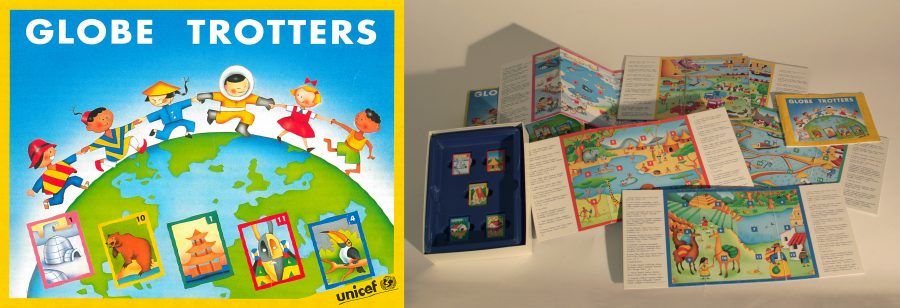
Left – Globe Trotters Board Game cover. Right – Globe Trotters game boards. (Photos by Paniz Moayeri.)
I asked this question of my mother as soon as I realized the concept behind the box. Here’s the problem, as you will notice in the picture: none of them do.
We were left with these options:
- The soccer-playing Latin girl with a pet llama.
- The Asian girl who wears a conical hat and works on the rice farm.
- An Inuit boy living in an igloo (whom we referred to as the Eskimo boy because to this day no one in Iran knows Eskimo is a pejorative term).
- The blond girl in a cute little dress who lives in a city and travels by car.
- The African boy who has bare feet, lives in a hut and has a pet cheetah.
You see the problem? My poor mother looked perplexed as she glanced up and down at the options and finally decided I was the white girl. She was the only character who was dressed like me, lived in a city, and ate similar food – it would do. I was sold. Iran is a multi-ethnic country, people come in every shade you can imagine. I had family members and friends whom you would label as white in Canada. I saw no problem being the white girl just because I was a shade or two darker. I had a lot more in common with her than anyone else in the game. Turns out, both my mom and I made a mistake in thinking we were white.

Globe Trotters playing pieces. (Photo by Paniz Moayeri.)
It only took about less than a week after starting school in Canada for me to realize the only friend I had made thought of me as “brown”. Turns out, she was “brown” too, since her background was Punjabi. I had no idea people could be “brown”. In Iran you were either “Light”, “Darker than Light”, “East-Asian looking”, or “Black”. I had never paused to consider the alternative before. You certainly couldn’t label my parents as “brown” that easily. My dad looks Italian enough that he frequently offends people in our Italian neighbourhood as he dumbfoundedly smiles at them when they extend greetings to him in a foreign language. My mom is no better. She is ethnically ambiguous enough that meeting a new person for her always means a round of twenty questions for her country of origin to be unveiled. We want to see what we feel safe around and can identify with.
I tell you this story because I need you to understand that I have this never-ending crisis with my identity. These days I tend to stick with Persian (because as I pointed out to Donald McKay recently the “Persians” usually get better treatment over the “Iranians”) and juggle around with my exact relationship to Shia Islam, the religion of my birth and upbringing. These struggles have made me who I am today and will continue to shape me as long as I live.
I am quite glad that there are no caricature versions of a Persian – maybe Muslim – Canadian girl on top of the globe smiling. The truth of the matter is, we live in a country of these malleable identities, identities which you can see more and more easily on the faces of each incoming first year class at this school, and to a lesser degree in our faculty members. And yet: almost none of this is reflected in our curriculum.
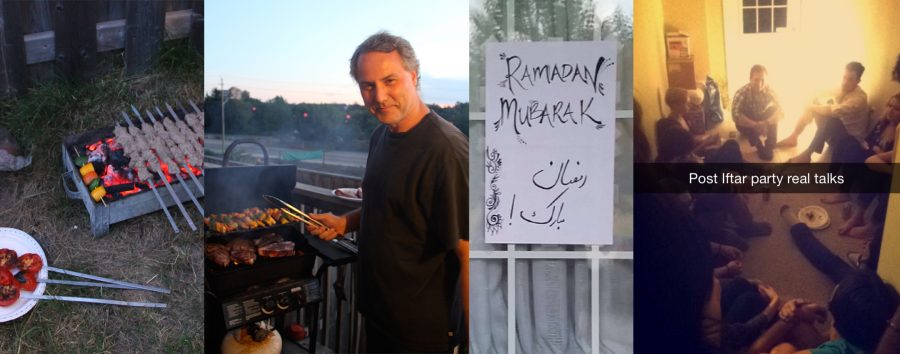
Left to Right – Persian Kebobs on a Manqal (Persian coal barbeque) – 2012 Iftar Dinner (photo by Paniz Moayeri), Wade manning the BBQ – 2012 Iftar Dinner (photo by Paniz Moayeri), Door Sign – 2015 Iftar Dinner (photo by Emily Guo), Post-Iftar – 2015 Iftar Dinner (photo by Safira Lakhani).
We as a close-knit school know where we stand, however. We throw Christmas parties where we wear ugly sweaters; we do Iftar potluck dinners where we all fast till dusk; we study the Holocaust in our first term as students here. We are the school with professors who emailed us, inviting us to talk about our feelings after the Paris attacks last year, where many shared our stories of immigration and alienation. We are the architecture school with the most diverse, interesting theses done on a multitude of topics covering all corners of the Earth.
Why is it then that we forget all of these tales when we design our curriculum?
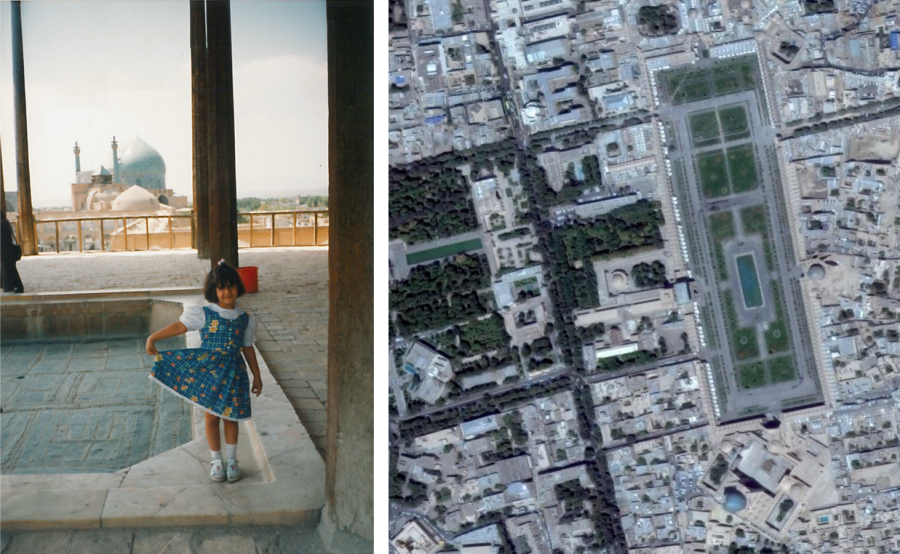
Left – Paniz at the Ali Qapu Palace Balcony. Jaame’ Abbasi Mosque (a.k.a. Shah Mosque) is visible in the background, diagonally across Naqsh-e Jahan Square. Isfahan, Iran – circ. 1998. (Photo by Farhad Moayeri.) Right – Naqsh-e Jahan Square: satellite view. (Google maps.)
In my entrance interview with Robert Jan in 2010, we somehow ended up talking about the design of Naqsh-e Jahan Square in Isfahan. I had only been there once as at five or six but, obsessed with the heritage I felt like I was missing, I had read about it. The square is a marvel of Islamic urban planning and a UNESCO World Heritage Site. I think my excitement mixed with my mismatched analysis of the site is what got me into the school. Robert Jan’s attention and line of questioning led me to believe that I would find people at the school who could teach me things I really wanted to learn about: questions that had followed me to Canada from foggy childhood memories of echoes in ancient mosques, reflections in mirrored halls, and scents in walled-off gardens.
That’s not exactly what happened.
Like a lot of people entering the school, I went through all the stages of cultural shock: bafflement, confusion, misplaced enthusiasm, anger, sadness, defeat, and lying to oneself about the state of one’s happiness. Somewhere early on along the way, I attempted to conform to what I was being told an architect had to be. To makes matters worse, as Donald MacKay put it, I became “obsessed with the score-board and forgot to play the game.”
My angst and desperate attempts to fit in subsided a little when my class was lucky enough to be taught by Tammy Gaber. She changed the 2A ICO readings that year and shifted the perspective from Bible dominated texts to a mixture of narratives that for the first time included the Muslim perspective during the crusades. I finally had a book like The Crusades through Arab Eyes to counteract the alienation The Song of Roland put me through.
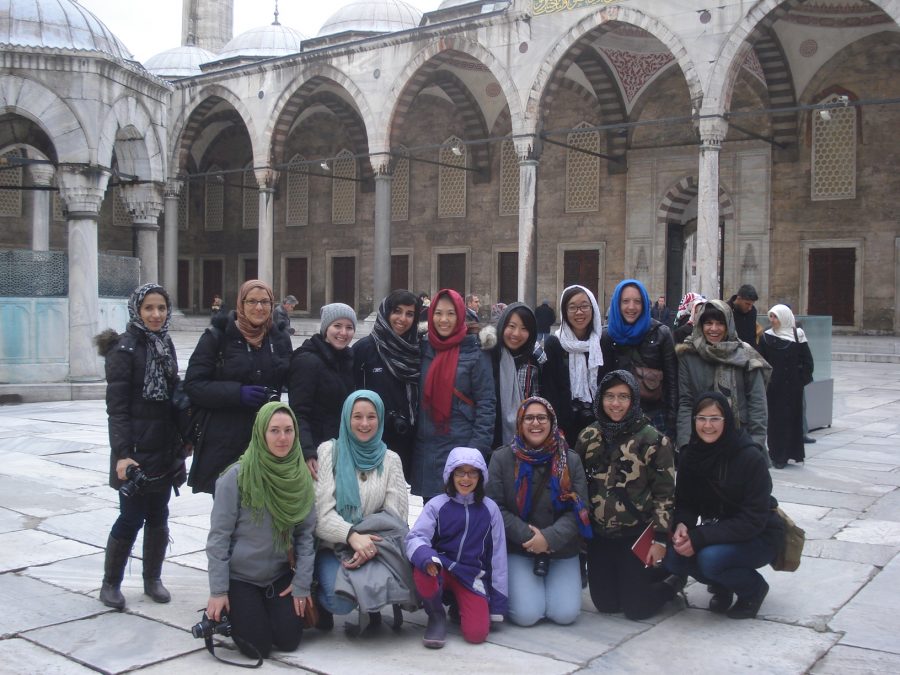
Girls of ARCH 384 with their professor Tammy Gaber in The Sultan Ahmed (a.k.a. Blue) Mosque’s main courtyard, Istanbul. (Photo courtesy of Michelle Duong.)
A year later, Tammy created a refuge for a small group of 3A and graduate girls (I still have no idea why only girls took the elective) who took her Islamic Architecture course. For the first time in three years, I sat through a lecture that mentioned Isfahan and gave credit where credit was due. I hadn’t just made it up in my head: there was considerable cultural history and design that we hadn’t been taught about before. We took a life-changing trip to Turkey, where we learned about Mimar Sinan, nicknamed “The Turkish Michelangelo,” drank tea and smoked in hookah lounges after long days of hiking the new culture, overwhelmed with information. We learned about the history which to that point had been a mere footnote; I filled up three moleskin notebooks for this half credit course. Most importantly, we practiced thinking analytically about this new world we were learning about in the papers we wrote for the class. New doors were opened. New ideas were accessible.
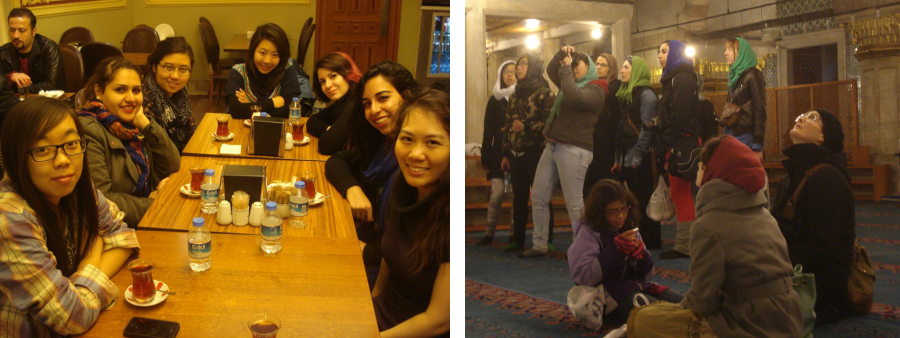
Left – End of day Tea at Taksim Sütiş, Taksim Sq. Istanbul. (Photo courtesy of Michelle Duong.) Right – Lecture at Yeni Valide Cami, Istanbul. (Photo by Michelle Duong.)
This happiness and new excitement I was feeling reflected itself in my other coursework as well. My marks improved overall; I became more confident in my instincts and the places I got inspiration from. I didn’t feel so bad when the latest starchitect monument did nothing to affect me emotionally. I laughed off moments of miscommunication when an adjunct thought my inspiration from a Persian Chahrbagh was a copy from a French garden.
Six years after I first started this education, I am now writing what Robert Jan would define as a classic “Backyard Thesis”. The work is confronting me with my heritage, the good and the bad. It is asking me where I stand and for what I take responsibility. It places me firmly with the outsiders amongst outsiders, a place I know a bit about. In this work, I have struggled to find the right literature to read. Foucault is enticing, but leaves much unanswered; Lefebvre is poetic but it doesn’t always add up; Soja sounds applicable but he loses me often. Amongst the piles of books growing at my desk, many are placeholders for texts I would really like to read but can’t seem to find.
One major thing has changed, however. I now don’t feel timid when implying in a conversation that perhaps a professor doesn’t quite know the context I am discussing. I no longer feel like what I have to say is invalid in an architectural discourse because the topic at hand doesn’t involve soft, foggy renders. I must add that I am not unique in this stance. I look around me and I see a group of graduate students who talk about their thoughts and emotions so eloquently, with such authority, that I feel proud to be included in their company. This is because we have all come into our own. For many like me, this came as a byproduct of finding a niche within architectural discourse, just off the mainstream, that catered to our interests. The architectural discipline for us is no longer defined in a binary reference to the latest Archdaily post.
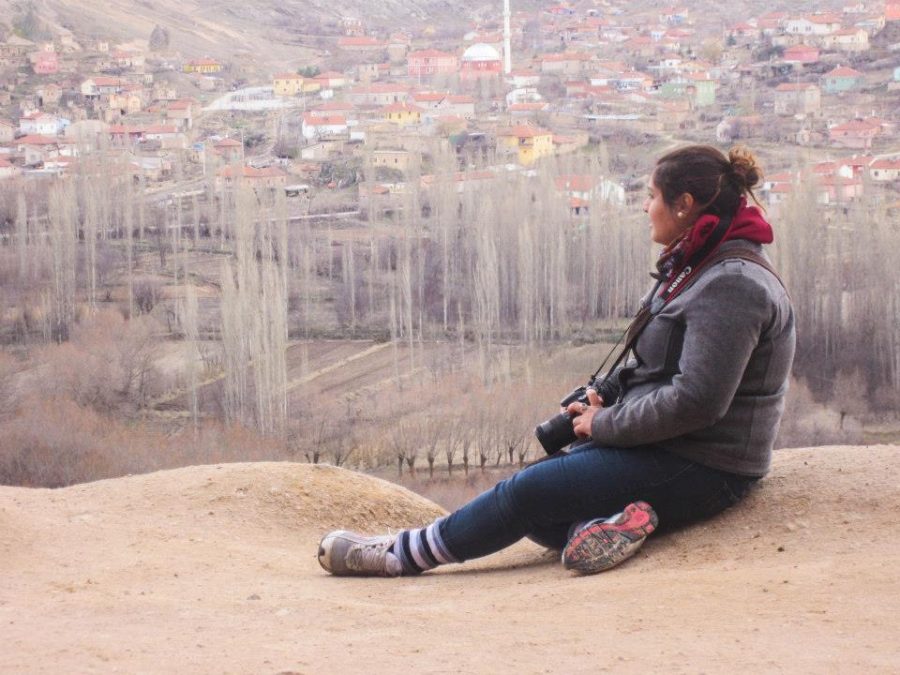
Paniz Looking at the landscape – Somewhere in Cappadocia, Turkey. (Photo by Christina Robev.)
This ability to empower students through the inclusion of different ideas and cultural standpoints is what we need to fight for. Personal experience has shown me how creativity dies when one feels alienated, afraid of falling behind, afraid of voicing ideas that are different. We as an institution need to come to terms with the fact that the reasons for which we admit students, and the narrowly-focused material we end up teaching them, don’t quite add up. Bjarke Ingels’ shiny renders were not why I wanted to be an architect – the work of some unnamed dead guy who designed the Shah Mosque in Isfahan was. My education didn’t always reflect that.
This year is an accreditation year. Last time, the accreditation committee told us there was a gender discrepancy in our faculty, and this is an issue our school has attempted to tackle in the years since. We have come a long way, with full-time positions offered to more women and the appointments of our last two female directors. There is more work to be done in that regard but we do have currently one of the most gender-balanced faculties among architecture schools in Canada. This shouldn’t blind us to other problems, however. We should look forward rather than back.
Look at the faces of the incoming 1A class and then compare them to the full-time faculty members. Even more, look at the cultural diversity of the 1A class and then compare this to the texts they are reading. If Martians were to land in Galt to try to gauge our cultural intelligence merely based on our ICO books, they would think the world rose and fell in Rome. We can do better.
This is why a group of us graduate students have come together with our director Anne Bordeleau to devise short and long term solutions to the problem of inclusion in our curriculum. There is a long, iterative road ahead and it will require everyone, the students and faculty alike, to work together.
We believe that our school has always – fundamentally – operated on the belief that to be good designers, we need to be culturally and historically aware, intelligent, and sensitive. These are important ideals our current curriculum has been based on for years. The richness of experiences, perspectives, and schools of thought we, as architecture students, are privileged enough to experience through the Rome program, the Cultural History stream, and the diverse electives offered are unique in architectural education. Our school is the best breeding ground for a more inclusive, diverse, and culturally aware curriculum. We are well-equipped to take up this challenge. We need your help to make it a reality.

Class of 2015 listens to Rich Haldenby’s annual lecture at the Roman Forum in the Fall of 2014, Rome. (Photo by Michelle Duong.)
It has taken me, personally, more than ten years to come to terms with who I am: a non-white, maybe brown, Persian girl who may or may not like being called Muslim (the latter depends on her mood). This journey has taught me that I need to not be passive about my position, my identity, my story. People like me are those who make up Canada’s story and we are here, present, at the School of Architecture. Let’s make it show.
Paniz Moayeri is a 2019 graduate of the M.Arch program from the University of Waterloo School of Architecture, where she also received her Bachelor of Architectural Studies in 2015. Her graduate thesis (entitled Your Passport Doesn’t Work Here: Asylum, Space, and Iranian Queer Heritage) looks at the connection between space and queer heritage in the Iranian LGBTQ+ refugee community of Toronto.




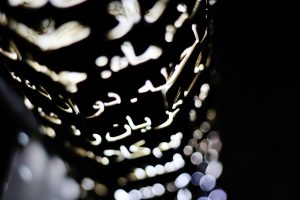
Leave a Reply